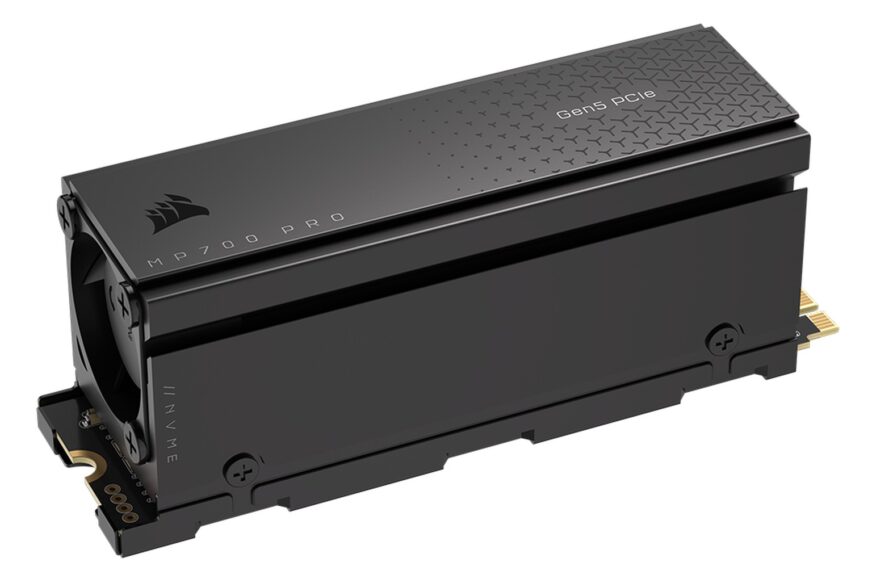Second-generation PCIe 5.0 SSD boosts performance thanks to new fast NAND chips
When SSDs using PCI Express 5.0 technology came to market, most models available delivered sequential speeds of “just” around 10 GB/s. The Phison E26 controller used is supposed to reach up to about 12.5 GB/s, but it turned out that with most of the NAND available on the market it only reaches that lower level bar between 9500 – 10 000 MB/s. Fortunately, things are getting better and the 12.5GB/s drives promised a year ago are coming.
One such SSD is the now released Corsair MP700 Pro. This is an upgrade of the PCIe 5.0×4 Corsair MP700 modules that use the Phison E26 controller and were exactly one of those SSDs running in the 10 GB/s category. It was also one of the very first PCIe 5.0 modules to become available for purchase earlier this year.
Corsair MP700 Pro: NAND Upgrade for fFull E26 Performance
Corsair is now releasing the MP700 Pro version, which was created by utilising newer TLC 3D NAND that uses an interface with an effective speed of 2000 MT/s instead of the previous chips communicating at an effective speed of 1600 MT/s while retaining the same controller (the PCB used is very similar). The NAND choice should be 1Tb chips with 232 layers from Micron according to reviews.
The Corsair MP700 Pro is offered in 1TB and 2TB capacities in M.2 2280 design. There should also be a 4TB variant later on – due out this winter. The module uses a DDR4 DRAM cache, which should be as high as 4GB for the 2TB module (likely 2GB for the 1TB capacity), and of course a PCI Express 5.0×4 interface with the NVMe 2.0 protocol.

Corsair states that these modules will achieve sequential speeds of up to 12,400 MB/s read and up to 11,500 MB/s write (this will likely be for writing to the pseudoSLC cache). Then, in random access, 1,500,000 IOPS in reads and up to 1,600,000 IOPS in writes. The company doesn’t provide a breakdown of these performance figures for each model, so it’s not certain that, say, the 1TB model isn’t a bit slower.
High read speeds should be useful, for example, in games that usr DirectStorage technology for texture loading. High-end gaming PCs should probably be the main target.
Large active cooler, or water cooling
Modules with the Phison E26 controller have become notorious for their relatively high power draw, which has caused some to suffer from throttling or shut downs due to overheating if there is insufficient cooling. Corsair solves this with a very tall passive cooler that has a 25mm fan mounted. Uncharacteristically, the fan is not at the top, but mounted on the drive in a vertical position the end of the module, so that it blows through the heatsink longitudinally. It could hopefully work more efficiently this way, especially if cold air from the front fans will be coming this way in the computer case.

At the same time, however, there will also be the Corsair MP700 Pro Hydro X version that has a copper water block with standard 1/4″ fitting threads instead, which you are expected to connect to a custom liquid cooling loop. In addition to these two cooled versions, cheaper variant of the modules without a cooler is also available, which is designed for motherboards providing their own custom heatsink. When buying these, however, it’s up to you to make sure the motherboard solution will have sufficient cooling capability.

The power draw corresponds to the cooler used, it is tad extreme as SSDs go. At idle, fortunately, the SSD has proper power saving modes and the power draw is less than 85 mW, but under load it can reach up to 11.5 W (which should be an increase over the MP700 model, where Corsair listed 10.5 W). In a laptop this would probably be quite a problem, in a desktop an efficient active cooler supplied from the factory should probably handle it.
However, it should also be said that in the context of a high-end PC or workstation, we think there’s actually not that much reason to complain that a NVMe SSD like this draws 12 W under load instead of the previously common levels of 7–9 W. Especially when at idle the power draw is negligible. Even Intel’s “mainstream” CPUs are now capable of drawing up to 300W under load (not to mention 360W Threadrippers) and even in games the CPU power draw is often in the 150–200W range these days, not to mention the power draw of a gaming graphics card. Which means that the power consumption of these SSDs is becoming something like the proverbial bucket in the ocean, relatively irrelevant in this scale. And unless this is a start of a longer trend of steadily worsening power draw (like what we saw in the world of CPUs and GPUs), then the whole issue seems to really be mainly a matter of handling the cooling needs (for now) and provided you have that covered, it’s fine.
According to Corsair, these SSDs should already be available for purchase. The 1TB version has an official price of 180 USD / 199 EUR (for the heatsinkless module) and the 2TB is officially set to cost 300 USD / 332 EUR. The release is also supposed to involve partner distributors, so hopefully the modules should be on offer locally in Europe soon as well. Reviews have also already been published, see for example ComputerBase.
Sources: AnandTech, Corsair, ComputerBase
English translation and edit by Jozef Dudáš
⠀









Finally an efficient implementation of an axial fan? Placing it at the beginning of an obviously tight tunnel seems more sensible than the traditional mounting from the top with respect to the pressure/airflow drop across fins.